Babylon
Visiting the Fabled CityThe Fabled City of Babylon
Babylon is probably the most famous place in the whole of Iraq, despite the fact that the hanging gardens are long gone. Archeologists aren’t even sure that they were actually in Babylon! However, the archeological site is impressive, as is Saddam’s summer palace, which sits on a hill overlooking them (he made sure he got the best view!). The site of the Tower of Babel is also here.
Anna and I set off from Mosul on a Covid lockdown day. The five-hour journey to Baghdad was smooth and, conveniently, the shared taxi dropped us at the Allawi south garage, which is where shared taxis and minibuses heading south leave from. However, it was closed due to Covid and a heavy Police presence was visible to enforce the lockdown. Unphased, enterprising iraqi taxi drivers had simply moved a hundred meters or so from the cops, where they hung out on the street looking for passengers!
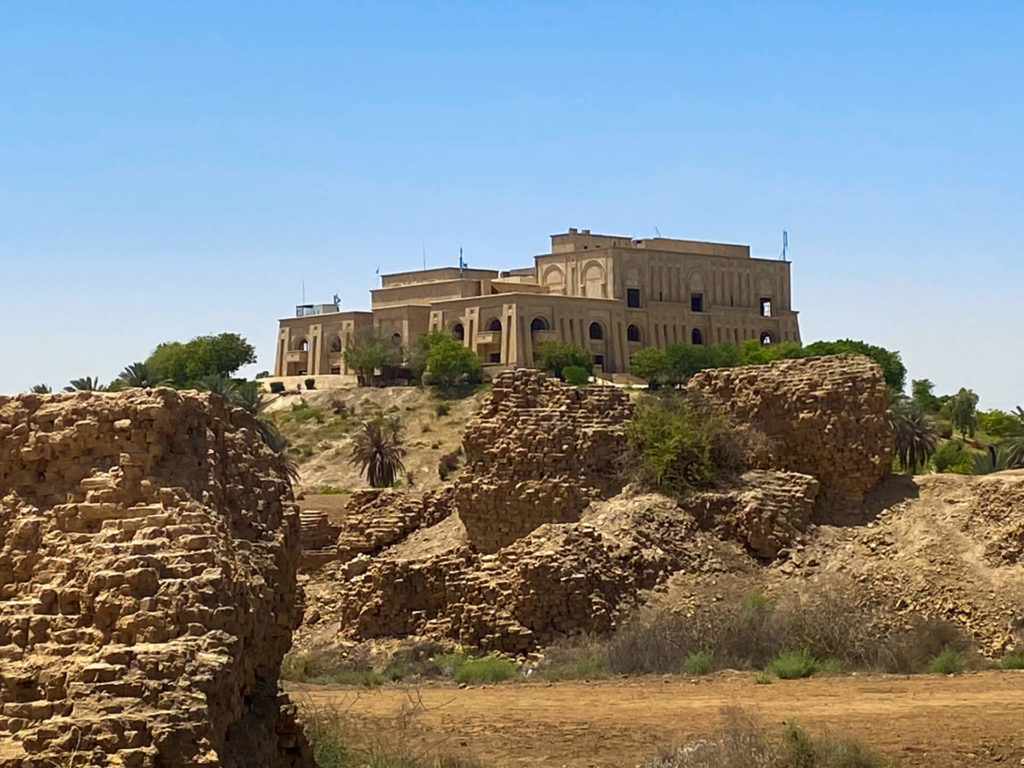
Saddam Hussain’s summer palace gave him a spectacular view over the ruins of Babylon.
The drivers told us that private taxis were the only option, because not many people were travelling during the lockdown. As we asked around, the price dropped from 60k IQD, to 40k then to 30k to Hillah, the main town next to Babylon. Just as we were about to take the 30k private taxi, a shared taxi driver pulled up in a car with two other passengers all ready to go, so we went to get into his car instead. However, the driver of the private taxi got pissed and they started to argue. He also blocked us from putting our backpacks in the boot.
After a lot of expletives were exchanged in Arabic, we jumped into the backseat next to one of the other passengers with our bags and slammed the door. Then our driver drove 500m down the street to get away, after which we stopped and transferred the bags to the boot. The other passengers thought it was a great laugh and we were soon joking about it, even though no one spoke English. The journey to Hillah took about 1 hour and cost 10k IQD ($7/€6) each.
Exploring Hillah
In Hillah, we were met by Haydir, a friend that another Iraqi friend in Kirkuk had connected us with, who kindly hosted us at his family’s house. He picked us up from a bridge on the edge of town, where the shared taxi left us, and took us on an afternoon sightseeing tour of Hillah before heading home.
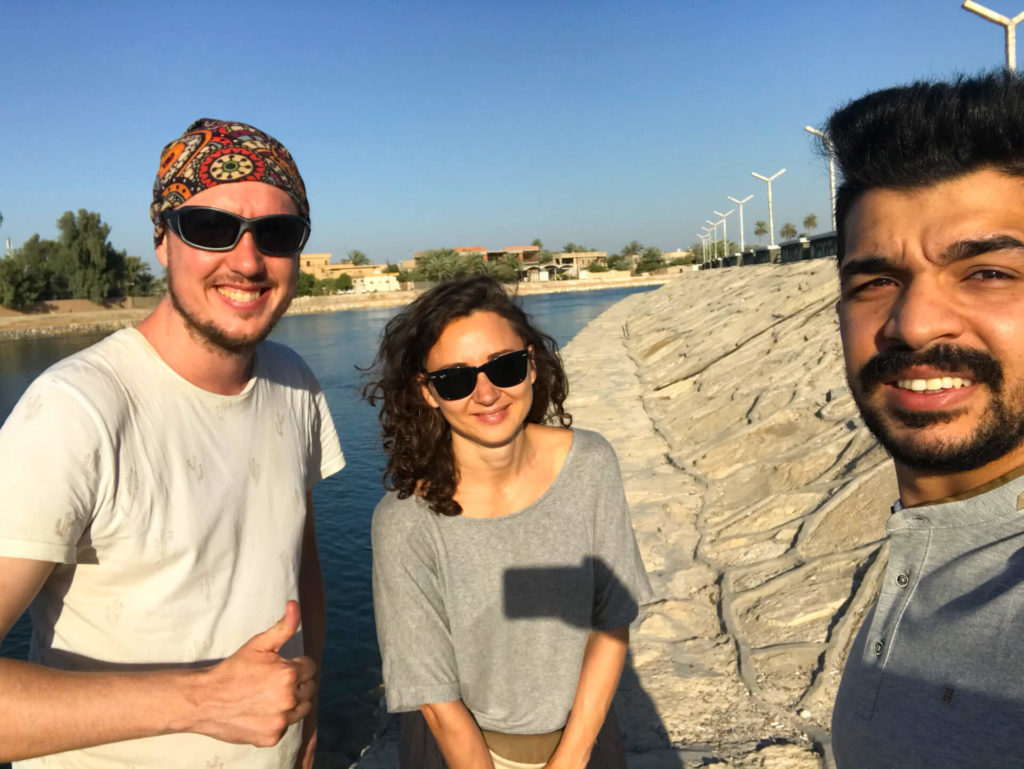
Chilling by the river. Or maybe cooking by the river. It was almost 40 degrees.
Most travellers just pass briefly through Hillah on their way to Babylon or stay in one of its hotels, as there are no major tourist draws here. However, it’s a vibrant little town. We visited a manicured waterfront by the Euphrates river, where Iraqis go to walk or chill in the evenings. As it was mid afternoon and approaching 40 degrees, it was pretty quiet when we were there.
Next, we visited the E Radeshams mosque. It’s nowhere near as grand as the ones in Najaf, Karbala or Samarra, but it’s very distinctive, with a very high domed roof. The locals inside were also really not used to foreigners. The guard at the entrance told me photography was forbidden inside the mosque, but when I entered everyone wanted to take selfies with me, so in the end I just went ahead and took some photos too.
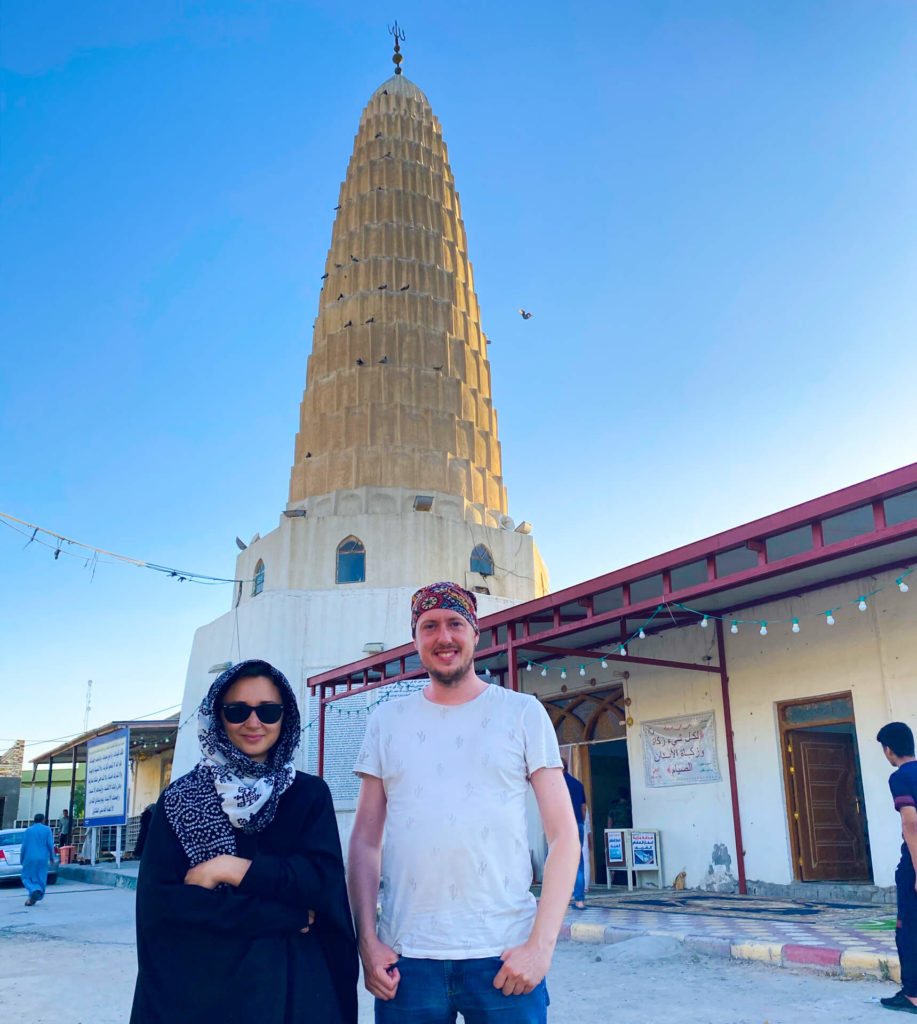
Dressed for Friday prayers.
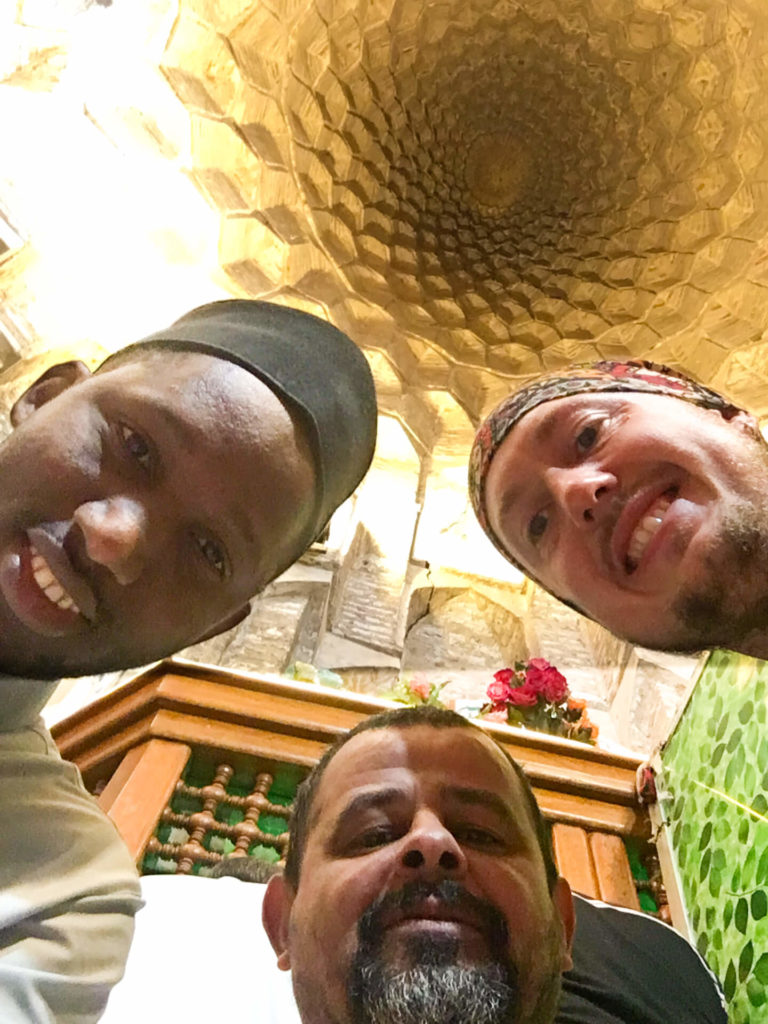
Everyone wanted to take selfies with me inside the mosque, despite the no photos rule.
Hillah Local Homestay
In the evening, we went back to Haydir’s family’s house in Hillah. We had tea in their living room and chatted for a while. As the sun set and the air became cooler, we moved to the garden for a delicious meal of chicken with rice. We ate with Haydir and his brother, sitting on little carpets on the ground in traditional Iraqi style.
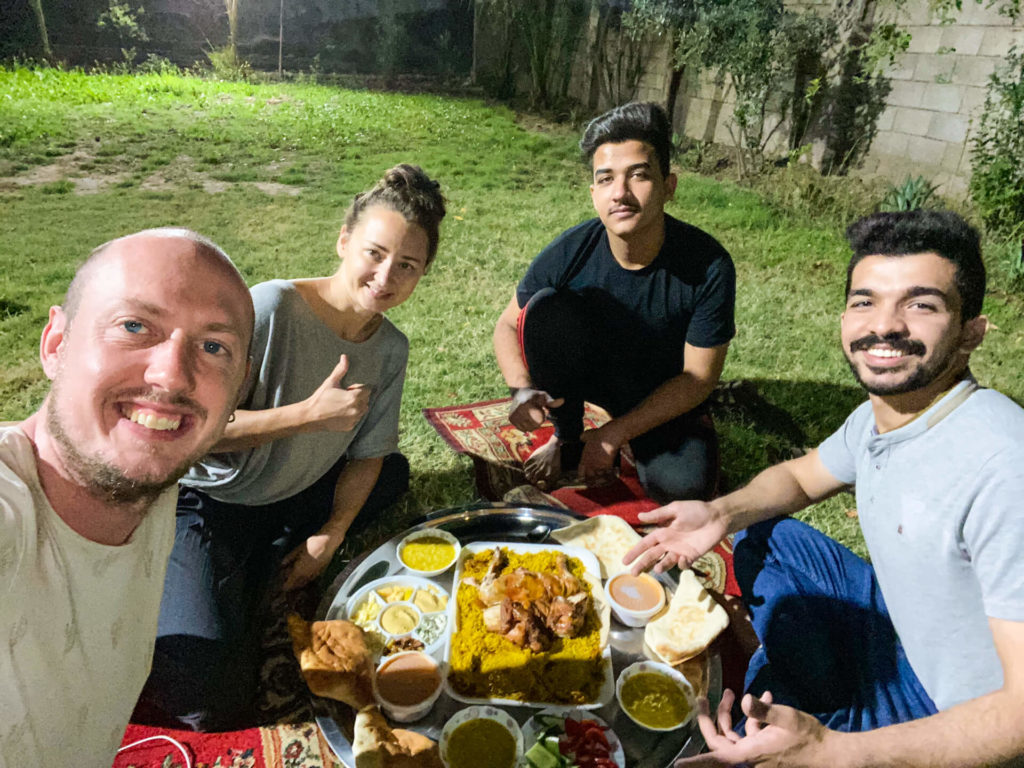
Dinner with Haydir and his brother.
Later, Haydir’s friends arrived and we spent a delightful evening playing backgammon and dominoes in the garden. I really enjoy backgammon and, after a lot of practice during Covid lockdowns while living in Beirut, I’m actually pretty good at it. It’s always fun to play with Arabs, because they invariably assume that, as a European, I’m a beginner and hardly know the rules. This time was no different. I played with one of Haydir’s friends, who was absolutely stunned when I won. Despite a thousand excuses on his part, his friends ribbed him for it for the rest of the evening, but it was all in good humour.
Anna played a few games of dominoes and then disappeared into the house to hang out with the female members of the family. This is a world that, as a guy, is completely closed to me. The whole time I was there, I never met any of the women, not even fully covered. Anna tells me that they did peek out at us from time to time, but would always make sure no one was there before crossing the public areas of the house.
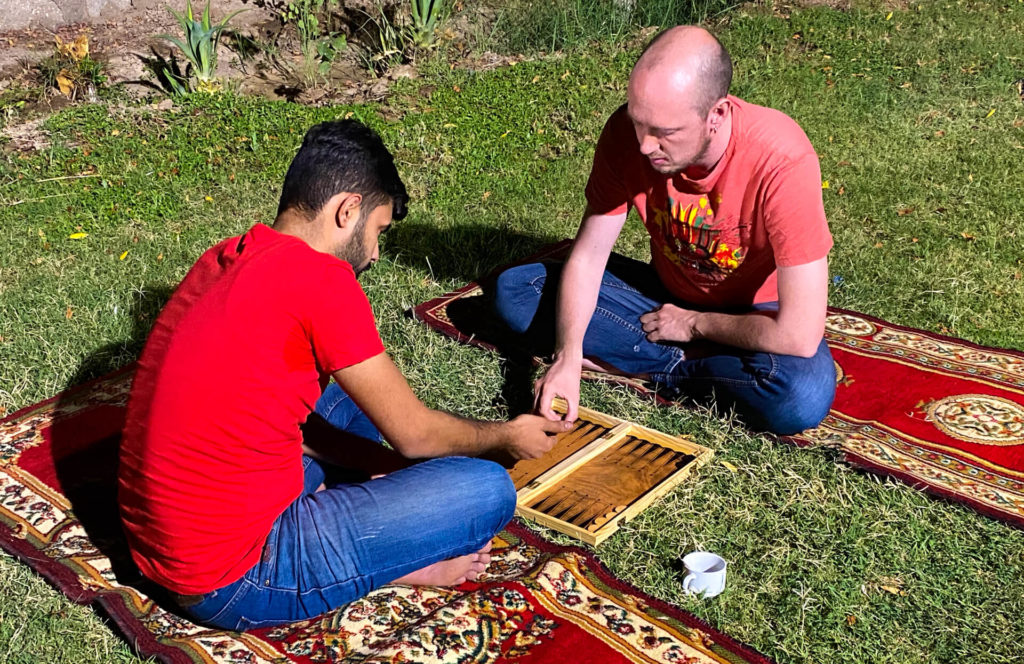
A tense backgammon battle!
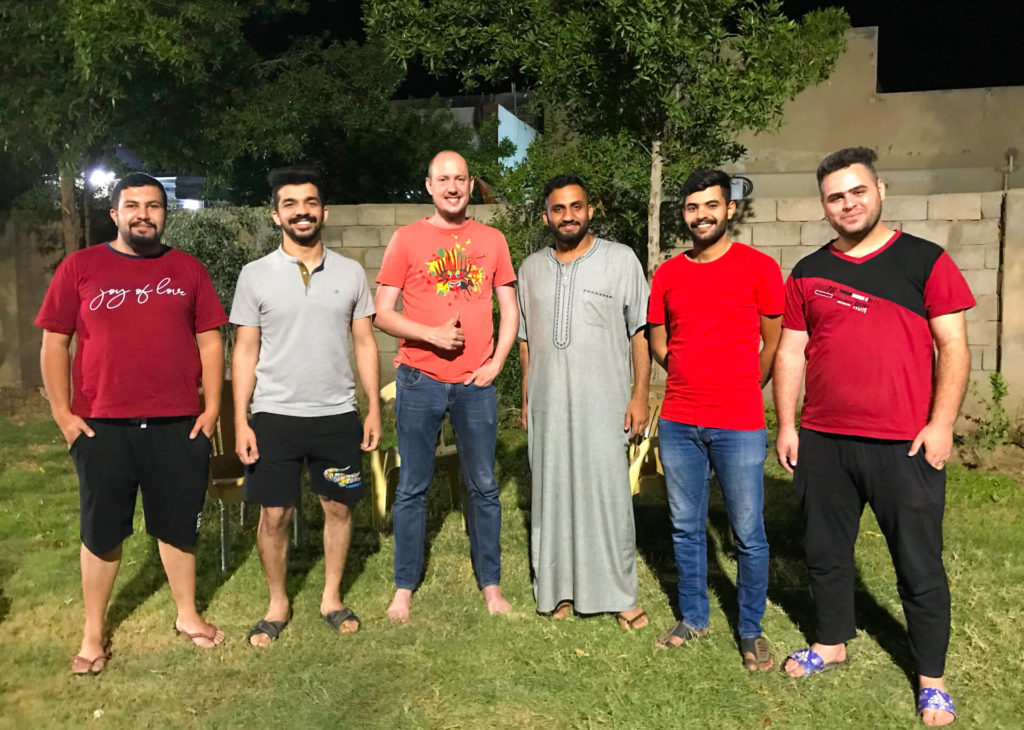
Chilling with the guys.
Historic Babylon
The next day, we got up early and drove out to Babylon, the name of which means “Gate of the Gods.” At two points in its history, around 1,700 BC and 400 BC, Babylon was the largest city in the world. The site of the historic capital of the Babylonian empire was also the location of the Tower of Babel and, more recently, Saddam Hussain’s summer palace. The hanging gardens may or may not have been somewhere here as well; no one’s really sure. There are theories that they were actually at the ancient city of Nineveh near Mosul, or even that they were just a myth and never existed at all (despite Young Pioneer Tours’ claim of taking you to see, “what’s left of them,” in Babylon).
All of the historic sites are in a single area with a 25k IQD ($20/€17) entrance fee. We paid and were joined by a local guide. Despite the sites being some of the most famous in the world, we didn’t see any other tourists the whole time we were there. Our guide took us first to an amphitheatre, which is over 2,000 years old, but has been restored, so as to look almost new. It’s beautiful, but I felt that during the restoration it has lost its historic feel.
Next, we went to the site of the Tower of Babel. I liked our guide, because he was happy to take us off the path. We scrambled up over some mounds of loose dark soil that apparently contains a lot of ash from foliage burn off. We sank almost knee deep at various points, but it was great to be able to get right up close to the site, even though there’s nothing much left to see. There’s the remains of a moat around a flattened area, where archeologists think the tower once stood. The river used to run by here, but has since been diverted. On the way back across the black dunes, our guide suddenly bent down and picked up an ancient coin, probably thousands of years’ old, that was just lying there on the ground.
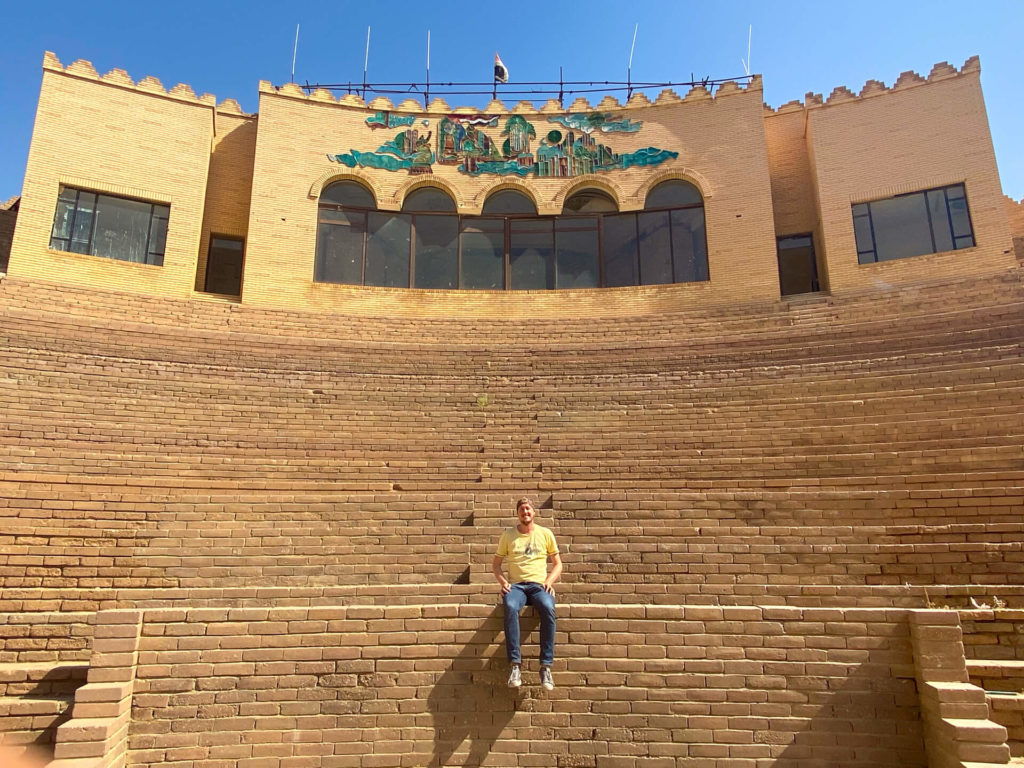
The beautiful Babylonian amphitheatre.
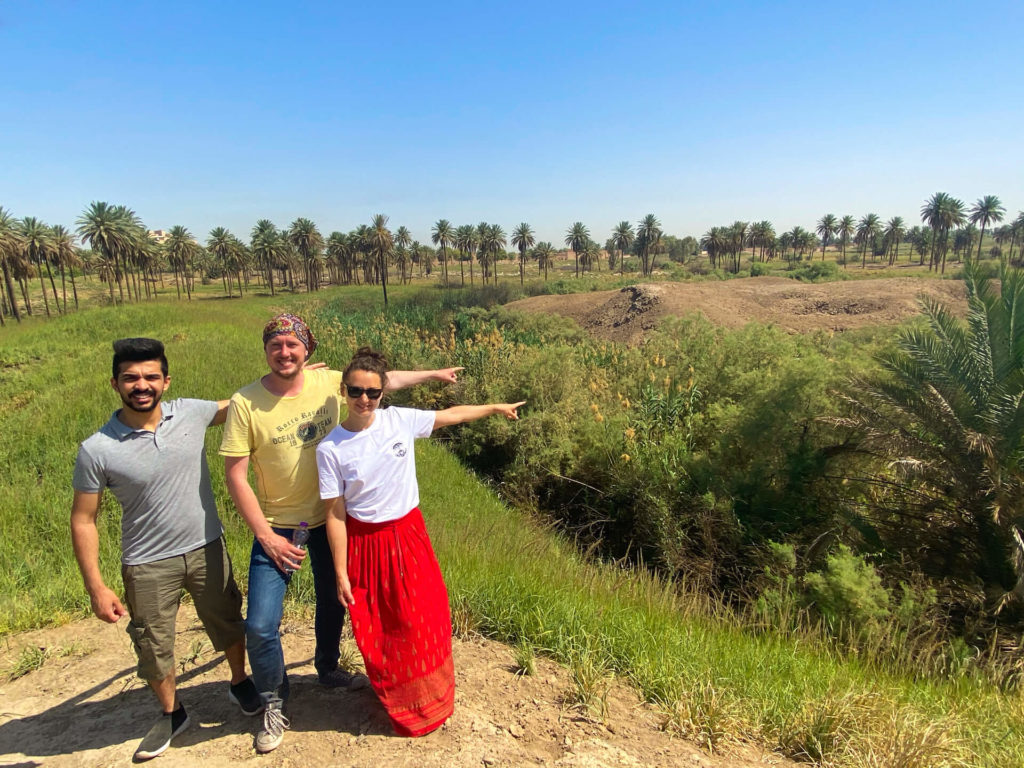
Look! The site of the Tower of Babel!
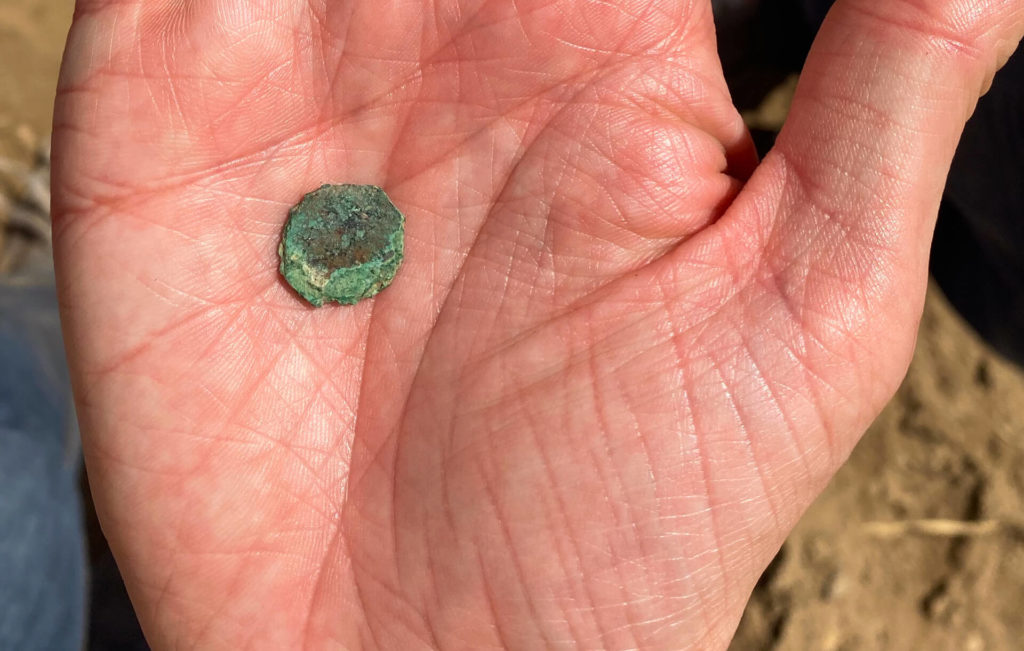
A 2,000+-year-old-coin that was just lying on the ground.
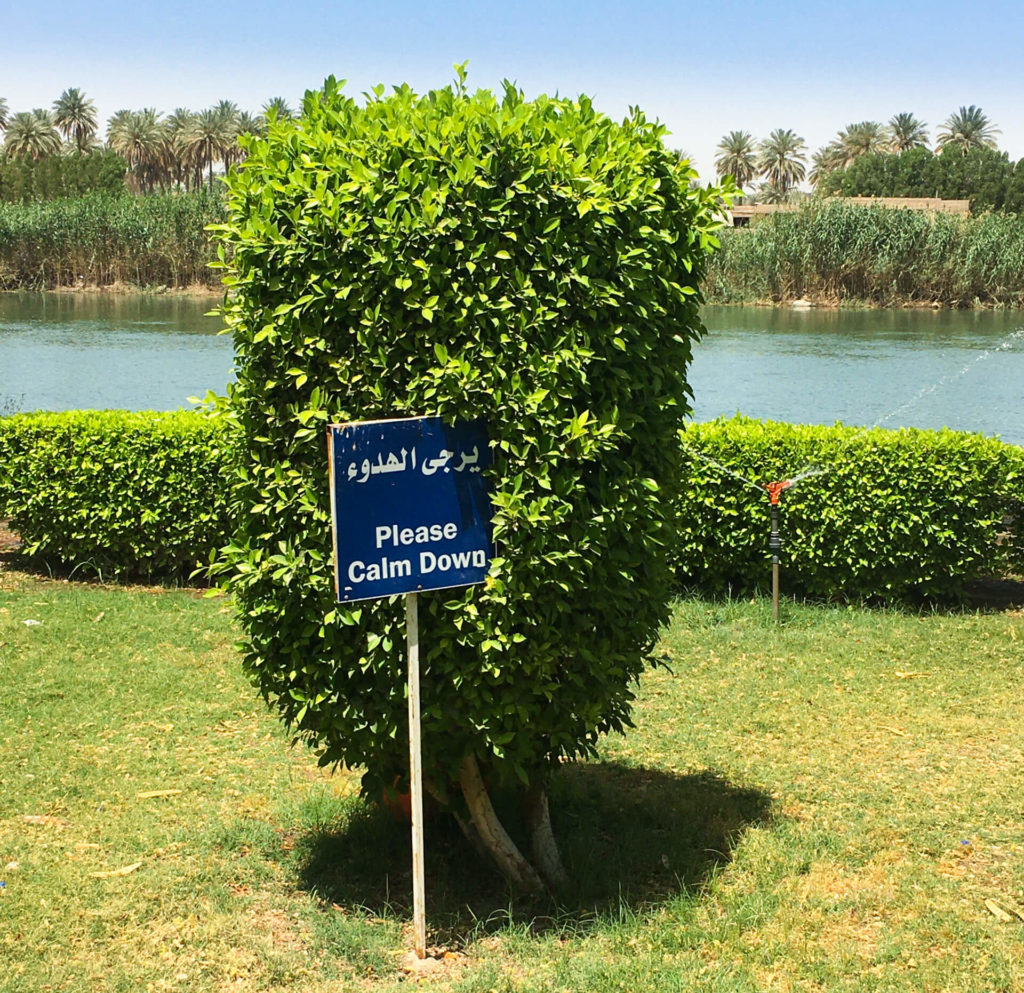
Just in case you weren’t chill enough, please!
Next, we visited Saddam Hussian’s summer palace. It’s on a hill right next to the ruins of Babylon and apparently caused a falling out with UNESCO, which was concerned about the cultural heritage that was destroyed during its construction. The result of the row was that Babylon only achieved world heritage status in 2019, long after Saddam’s demise. The palace is in a state of decay, and covered in graffiti from US and Polish troops that once used it as a base, but structurally sound.
Some of the artwork on the palace walls is impressive, depicting landmarks from around Iraq during Saddam’s era. The style is very much as you might fight on painted ceilings in European castles, except the content is much more modern, including oil wells and television towers. It’s a weird juxtaposition of old and new. The views from the windows of the upper floors were impressive. As elsewhere in Iraq, the land is almost entirely flat (except for the hill on which the palace is built), but here it’s covered in palm plantations, the largest in Iraq.
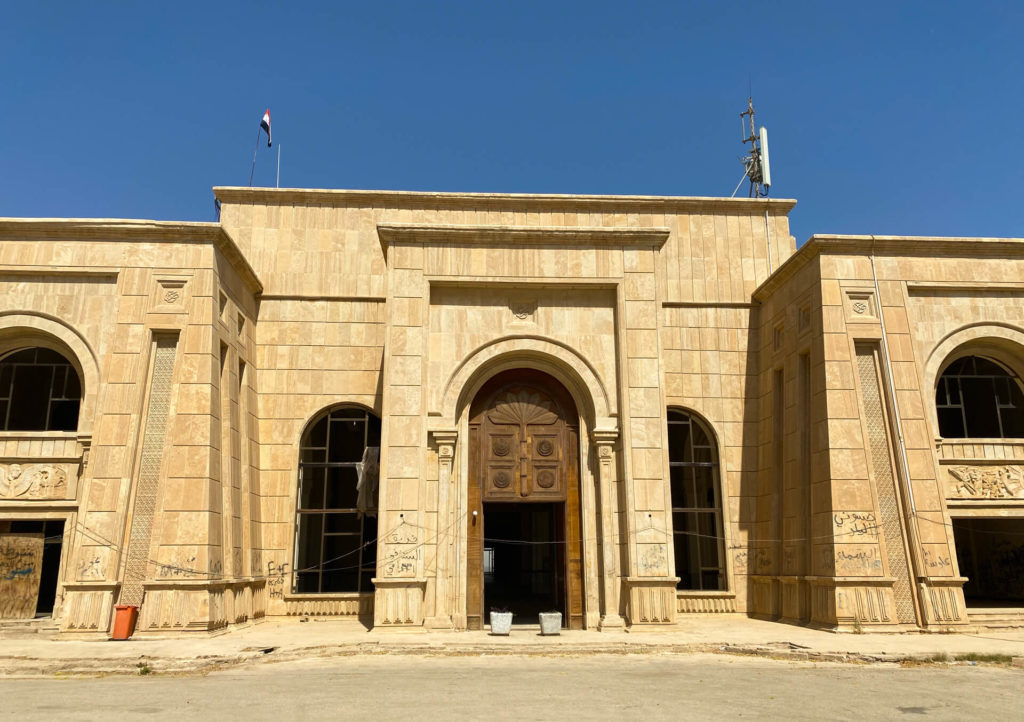
The impressive entrance to Saddam Hussain’s summer palace. The shape is loosely modelled on the Ziggurats of ancient Mesopotamia.
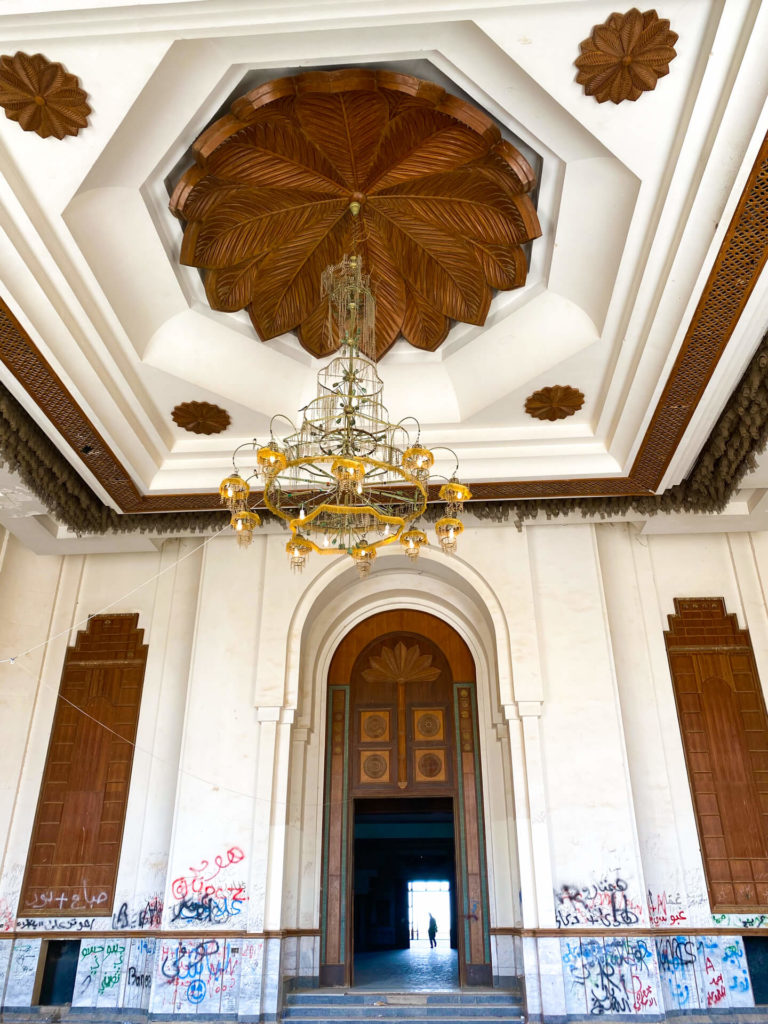
The wooden parts of the palace interior are made from Lebanese cedar wood.
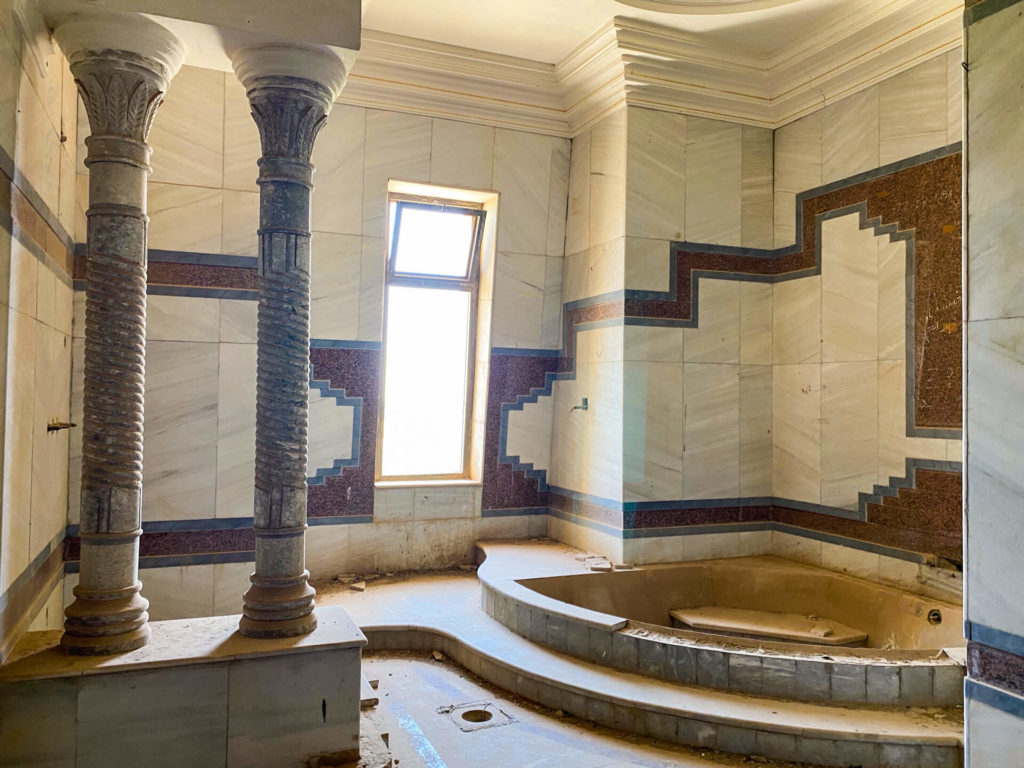
Saddam’s bathroom – even a dictator feels the call of nature occasionally.
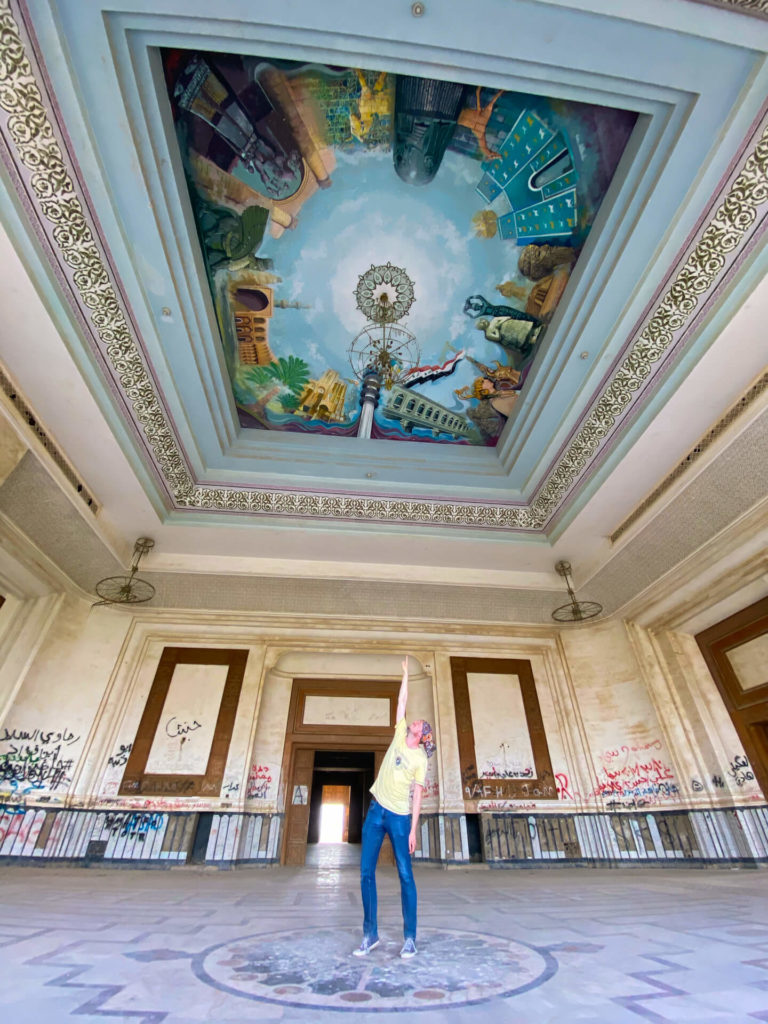
The beautiful painted ceilings of Saddam’s Palace.
Our next stop was the replica of the upper part of the famous Ishtar gate. The real one is spread across various museums, from London to Istanbul, with the main parts being in the Pergamon museum in Berlin. It is highly photogenic and we took a good few pictures there. The artwork on the gate depicts Marduk, the God of the city of Babylon, with a unicorn’s horn and the claws of an eagle. He actually looks rather cute!
The remains of the historic city cover quite a large area and we spent a good couple of hours walking through them. Many were renovated or even rebuilt under Saddam Hussain and are in good condition, giving a feel of what the ancient city was like. The highlight was the lower part of the Ishtar Gate, which is the genuine original – the Germans only took the upper section. The lower section is unpainted stone, so not blue, but is also covered in cute carvings of Marduk.
Next, our guide pointed out some 3,000-year-old text carved on a brick, which lay on the ground. He even encouraged me to pick it up for a photo! This probably shouldn’t be allowed, but I couldn’t resist. I was very very careful not to drop it.
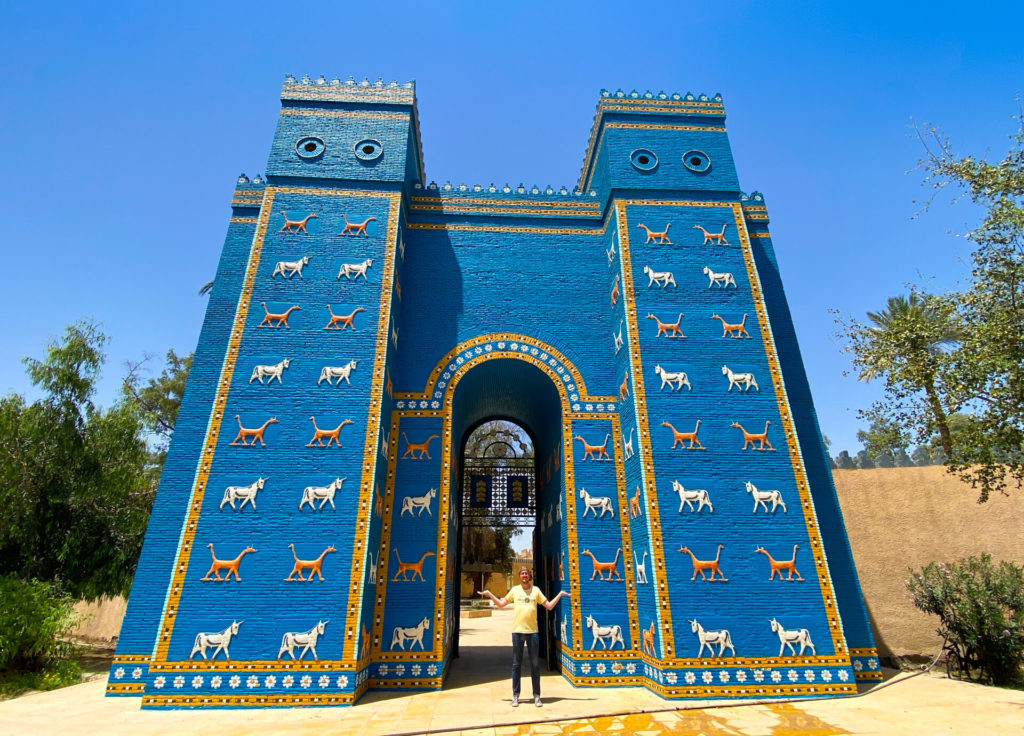
The replica of the upper part of the Ishtar Gate. It may not be original, but it’s certainly photogenic.
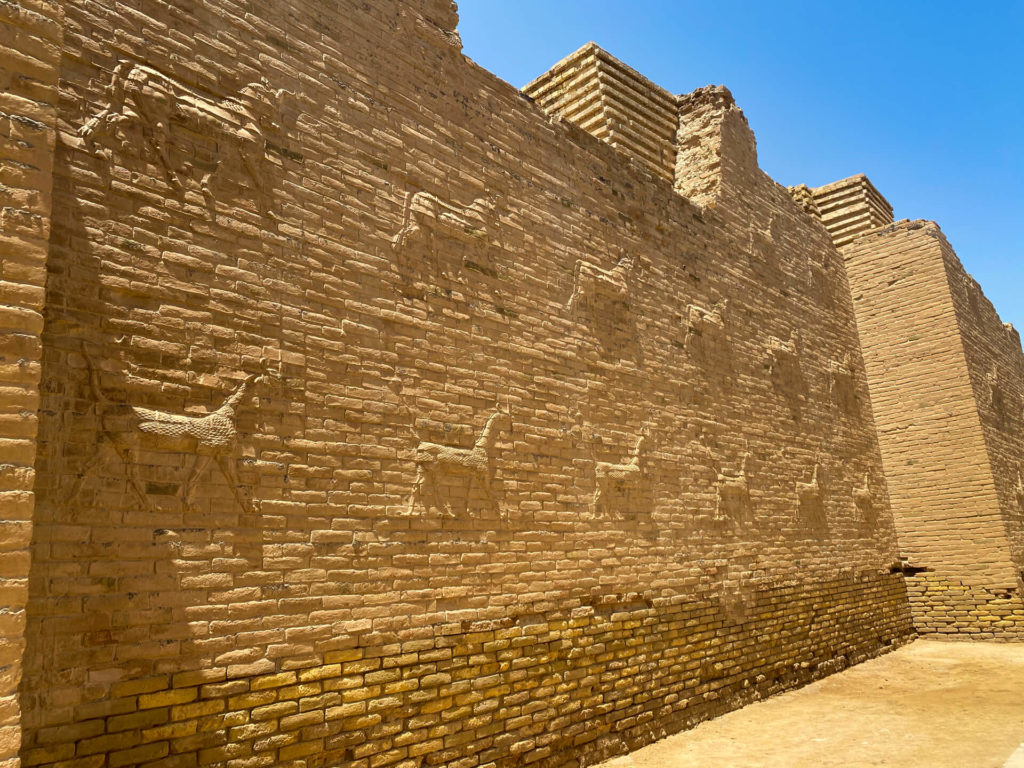
The lower section of the Ishtar Gate. This is original, as are the carved Marduk designs.
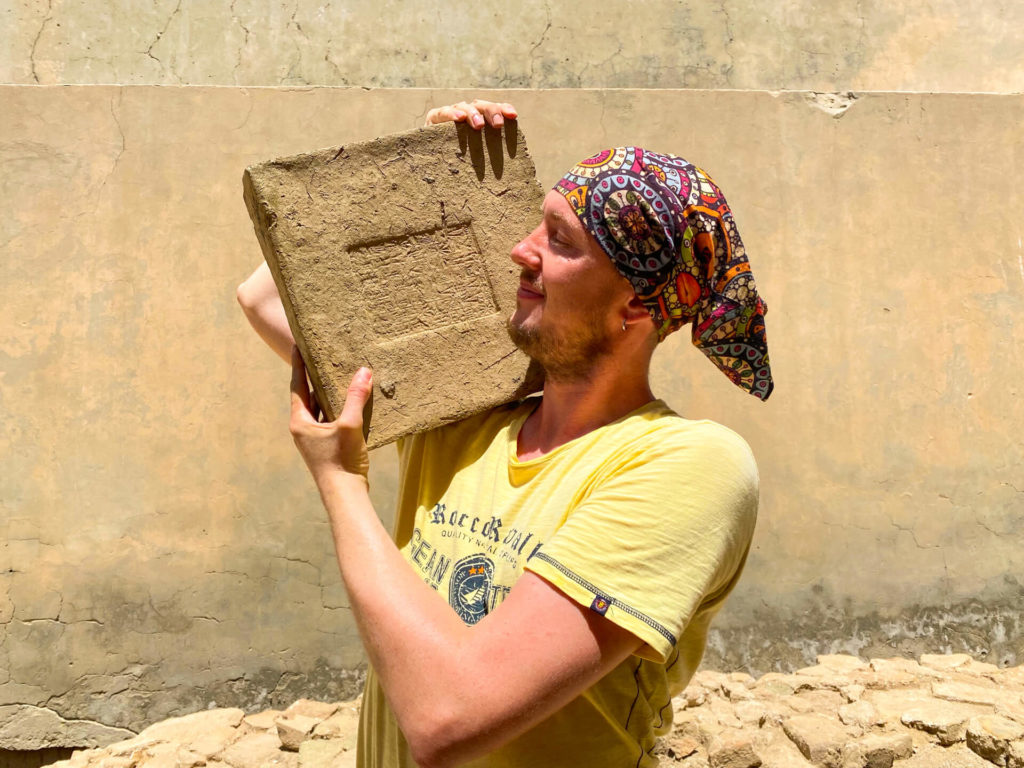
The earliest writing ever discovered was in Iraq. This is not it, but it’s also around 3,000 years old.
Another highlight was the 2,600-year-old Lion of Babylon statue. Wikipedia says that it was badly damaged by tourists climbing over it, so a barrier was erected to protect it in 2013. However, our guide was quite happy for me to climb right over it for a photo.
Finally, we walked back through a maze of passengers. I wanted to get lost in it, but our guide knew his way without ever even pausing for thought. His family comes from the area and he told us that he’s been working as a guide at the site for many years. We also passed a series of huge archways that were impressive, but not quite aligned with one another, so it was impossible to see from one end of the corridor they formed to the other. “That’s deliberate,” our guide told us, “so that would-be assassins can’t shoot straight through.”
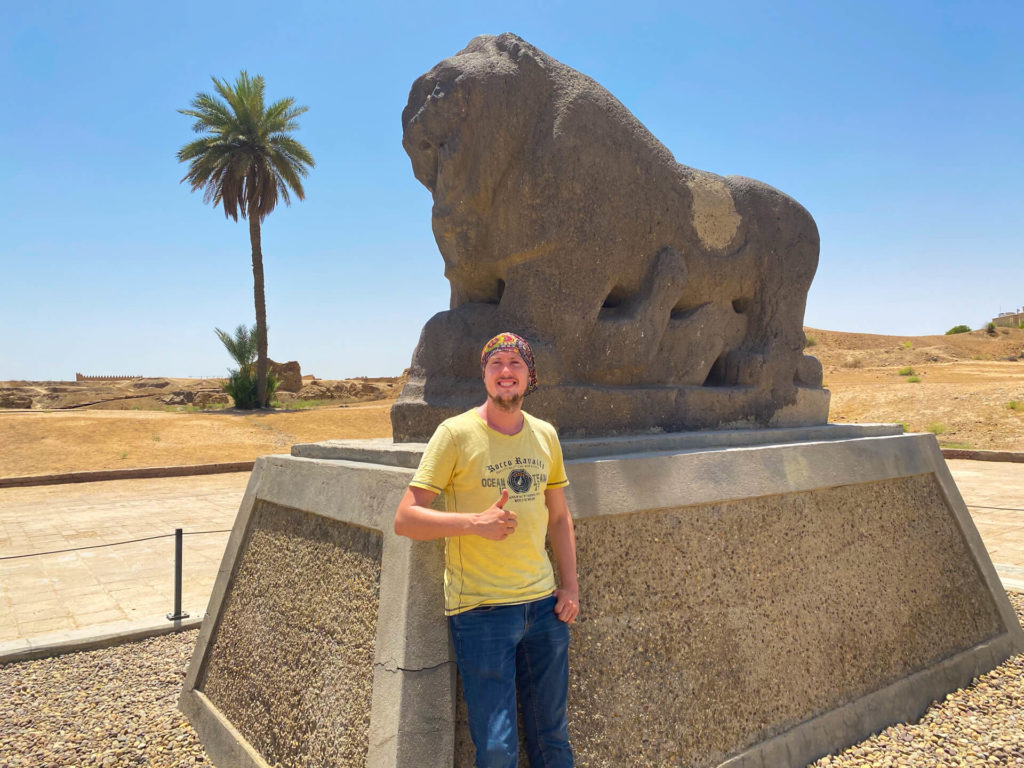
The Lion of Babylon statue, representing Ishtar, the goddess of fertility, love, and war.
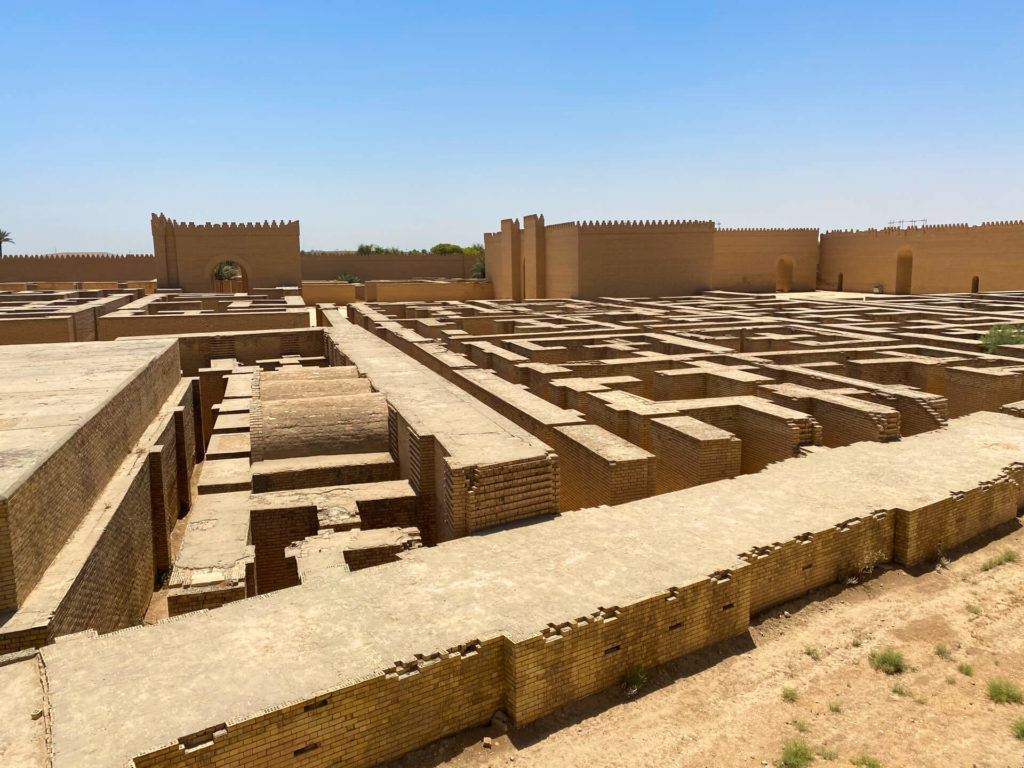
The restored section of the ruins is a total maze.
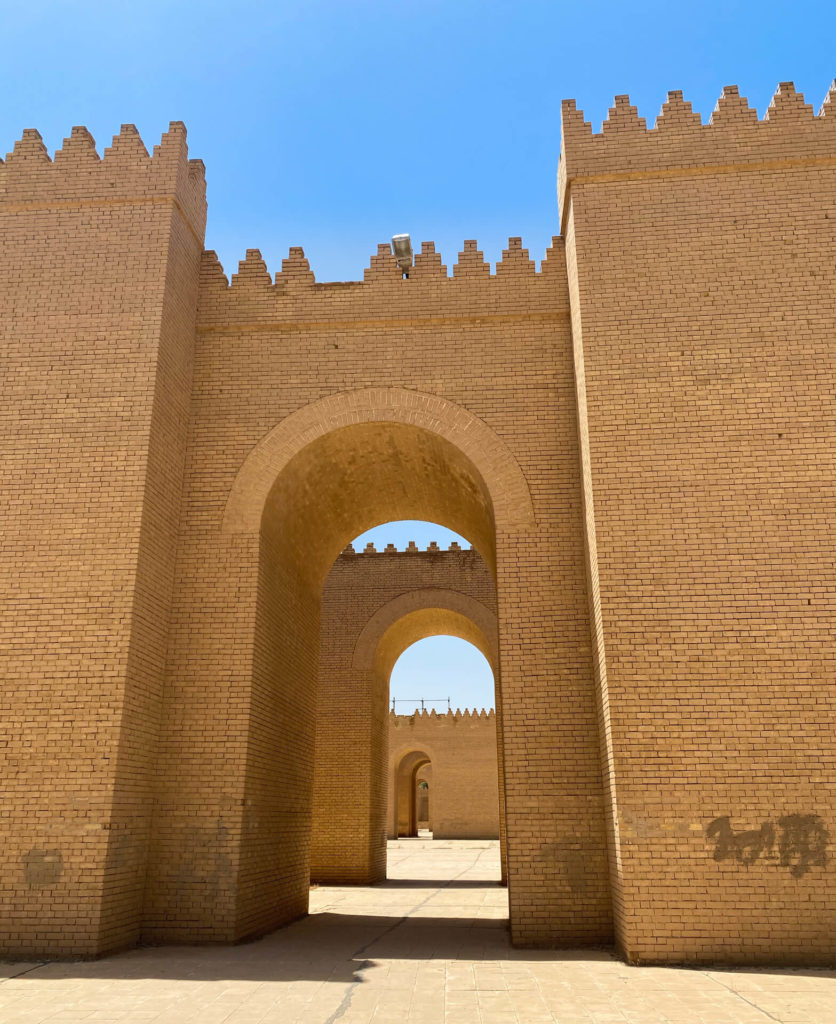
The misaligned archways protect the king from assassination.
Time to Keep Moving
We’d been out in the hot sun for over four hours by the time we left the historic sites of Babylon. There is a lot to see here. Afterwards, we had a delicious dinner back in Hillah and then Haydir helped us find a shared taxi on to our next stop – the holy city of Najaf.
Babylon is beautiful and a must-see for anyone travelling through Iraq. These sites are so famous that I expect the majority of the world’s population has heard of them, but very few have actually seen them. The ruins are interesting and beautiful and, even though there isn’t much to see of the Tower of Babel, just knowing that you’re looking at the spot where the fabled tower once stood is thrilling in itself.
How to Visit Hillah and Babylon
- To reach Hillah from Baghdad, take a shared taxi from the Allawi South garage (approx. 1 hour, 10k IQD/$7/€6). Shared taxis also have direct connections from Najaf (approx. 1 hour, 7,500 IQD/$5.20/€4.25) and Karbala (approx. 1 hour, 10k IQD/$7/€6). Prices may vary a bit depending on your particular driver.
- The historic site in Babylon is a few kilometers from Hillah and can be reached by taxi for 5k IQD/$3.50/€3 (one way).
- Admission to the historic site is 25k IQD ($20/€17), payable at the entrance, including your guide and access to the historic amphitheatre, site of the Tower of Babel, Saddam Hussain’s Summer Palace and the ruins of Babylon.
- We were lucky, because Haydir offered to host us. If you’re staying in hotels, it’s best to stay in Hillah, as Babylon doesn’t currently have any. Our Iraqi friends recommended the Asad Babil Hotel as being a comfortable mid-range hotel.
- If you prefer not to stay overnight, Babylon could also be done as a day trip from Baghdad. Another option is to combine it with Taq Kasra, which is between Baghdad and Hillah.
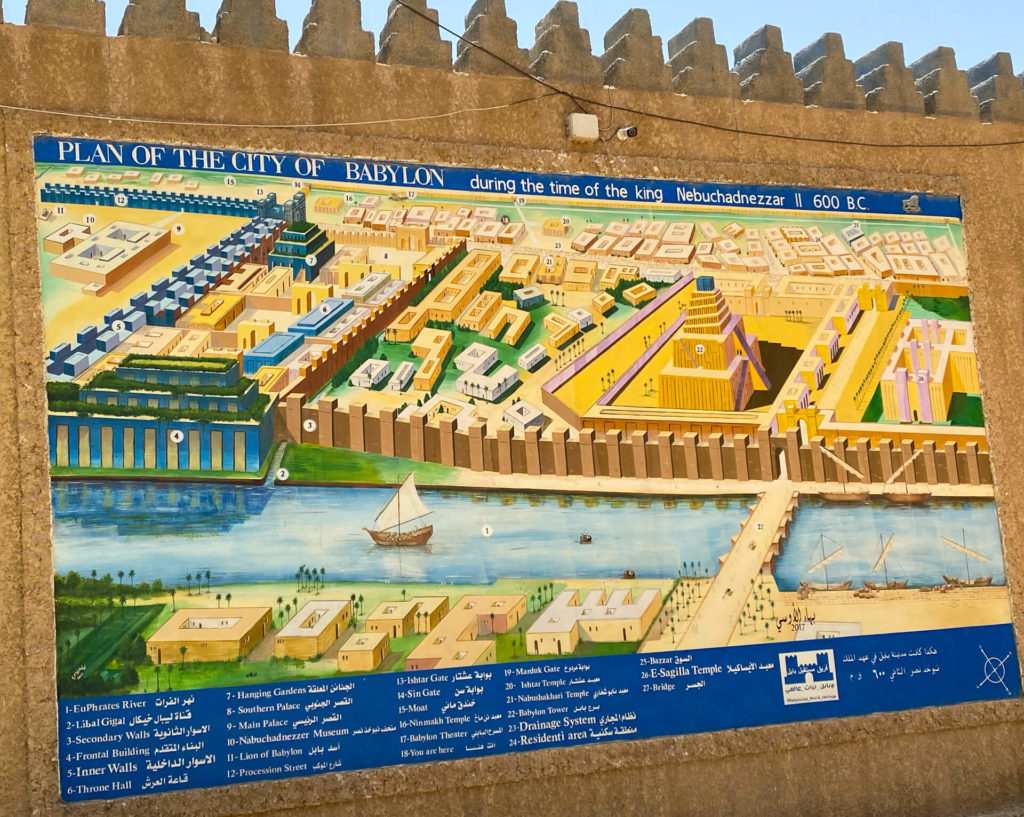
A map of the sights of Babylon before the city’s destruction.
More About Iraq
If you’re thinking about visiting Iraq or just curious about how people do visit a country that, until recently, was completely off limits even to the most hardcore of travellers, check out my complete travel guide to Iraq. See my other articles on Iraq here:
Iraq Independent Travel Guide
How to Travel Iraq Independently and Stay Safe Last Updated: 25 Feb 2023. This is my comprehensive guide to backpacking Iraq without a guide or tour group, updated continuously with the latest information. A lot of people have the impression that Iraq is an...

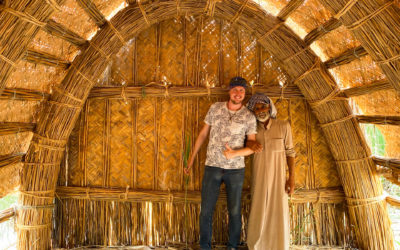
Wonderful, i hope to visit it soon
Awesome, I’m sure you’ll have an amazing time!
Hello, Rowan. I visited Saddam’s Palace today but couldn’t find Saddam’s bathroom. Was it upstairs? Unfortunately the entire upstairs was intentionally blocked off when I visited.
Hi mate. Yes, Saddam’s bathroom was upstairs. It was also blocked off when I was there, but they guy who showed us around took us up anyway. Probably a small ‘tip’ would have opened it!
Hi,
I have a quick question. Is Saddam’s palace located on or near the site of ancient Babylon? Would you say it is located within the boundaries of the ancient city of Babylon? Or is it located near the site of the ancient city? Some online articles say it is located near the ancient city while others say it was built on the ruins of the ancient city. Because of this conflicting information, I’m not exactly sure what to believe. I read one article that says the palace was built in the former village of Qawarish near the ancient city of Babylon. Do you have any idea what the correct information is? Thanks.
Hi Victor. Saddam’s Palace is located next to the historic site of Babylon. That said, the whole area is full of ancient artifacts from the Babylonian period, so I don’t think it can really be considered to be outside of the site of the ancient city either. Apparently, UNESCO was really upset when Saddam built the palace, due to the possible damage to historic artifacts there. Not sure whether this helps answer your question or not.